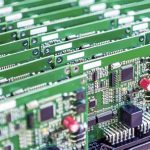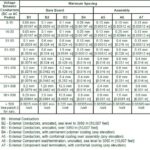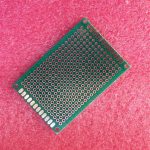Introduction to Fiducial Marks
Fiducial marks, also known as fiducials or alignment marks, are small, precise features placed on printed circuit boards (PCBs) to serve as reference points for automated assembly equipment. These marks help machines accurately locate and orient the PCB during the manufacturing process, ensuring precise component placement and improved overall quality.
What are Fiducial Marks?
Fiducial marks are typically circular, cross-shaped, or diamond-shaped patterns etched onto the surface of a PCB. They are designed to be easily recognizable by machine vision systems, which use cameras to detect and analyze these marks. The specific shape, size, and placement of fiducial marks may vary depending on the requirements of the assembly equipment and the complexity of the PCB design.
Purpose of Fiducial Marks
The primary purpose of fiducial marks is to provide a reliable reference point for the automated assembly equipment to accurately position and orient the PCB. This is particularly important for surface mount technology (SMT) assembly, where small components are placed on the PCB with high precision. By using fiducial marks, the machine can compensate for any slight misalignments or rotational errors that may occur during the loading process.
Types of Fiducial Marks
There are several types of fiducial marks used in PCB Assembly, each serving a specific purpose. The most common types include:
Global Fiducial Marks
Global fiducial marks, also known as panel fiducials, are placed on the edges of a panel containing multiple PCBs. These marks are used to align the entire panel before the individual boards are separated. Global fiducials ensure that the panel is correctly positioned and oriented in the assembly machine, minimizing the risk of misalignment during the manufacturing process.
Local Fiducial Marks
Local fiducial marks, also referred to as board fiducials, are placed on individual PCBs. These marks are used to align and orient each board separately, ensuring precise component placement. Local fiducials are particularly important for double-sided PCBs, where components are placed on both sides of the board. By using local fiducials, the machine can accurately align the top and bottom sides of the PCB, preventing misalignment issues.
Component Fiducial Marks
Component fiducial marks are used to align specific components on the PCB, particularly those with fine pitch leads or large packages. These marks are typically placed near the component itself and help the machine vision system accurately locate and orient the component during placement. Component fiducials are especially useful for high-density PCBs with tight tolerances.
Fiducial Mark Design Considerations
When designing fiducial marks for a PCB, several factors must be considered to ensure optimal performance during the assembly process. These considerations include:
Size and Shape
The size and shape of fiducial marks should be chosen based on the capabilities of the machine vision system and the specific requirements of the assembly equipment. Typically, fiducial marks are circular, with a diameter ranging from 1 mm to 3 mm. However, cross-shaped or diamond-shaped marks may also be used, depending on the preferences of the manufacturer.
Contrast and Color
Fiducial marks should have high contrast against the background of the PCB to ensure easy detection by the machine vision system. Copper fiducials on a green solder mask background provide excellent contrast. If the PCB has a different solder mask color, such as black or white, the fiducial marks should be designed to maintain high contrast. In some cases, soldermask-defined fiducials (SMD fiducials) may be used, where the soldermask is removed to expose the bare copper, creating a high-contrast mark.
Placement and Clearance
Fiducial marks should be placed in areas of the PCB that are free from components and other features that may interfere with the machine vision system. It is important to maintain adequate clearance around the fiducial marks, typically at least 3 mm, to ensure that the marks are easily detectable and not obscured by nearby components or solder joints.
Quantity and Distribution
The number and distribution of fiducial marks on a PCB depend on the size and complexity of the board, as well as the requirements of the assembly equipment. For smaller PCBs, two or three local fiducials may be sufficient, while larger or more complex boards may require additional marks. Fiducial marks should be distributed evenly across the PCB to provide a stable reference for the machine vision system.

Benefits of Using Fiducial Marks
Incorporating fiducial marks into PCB designs offers several key benefits for the manufacturing process, including:
Improved Alignment Accuracy
Fiducial marks enable automated assembly equipment to precisely align and orient the PCB, resulting in improved placement accuracy for components. This is particularly important for high-density boards with small components and tight tolerances, where even slight misalignments can lead to defects or reliability issues.
Increased Production Efficiency
By using fiducial marks, automated assembly equipment can quickly and accurately locate and position the PCB, reducing the time required for manual alignment and adjustment. This increased efficiency translates to faster production times and higher throughput, ultimately reducing manufacturing costs.
Reduced Assembly Errors
Fiducial marks help minimize the risk of assembly errors, such as component misplacement or rotation, by providing a reliable reference for the machine vision system. This leads to fewer defects and improved overall quality of the assembled PCBs, reducing the need for rework or repairs.
Enhanced Quality Control
The use of fiducial marks allows for more consistent and repeatable assembly processes, enabling manufacturers to maintain tighter quality control standards. By ensuring accurate component placement and alignment, fiducial marks contribute to the production of higher-quality PCBs with improved reliability and performance.
Best Practices for Implementing Fiducial Marks
To effectively implement fiducial marks in PCB design and assembly, consider the following best practices:
Collaborate with the Assembly Manufacturer
Work closely with your assembly manufacturer to determine their specific requirements for fiducial marks, including preferred size, shape, and placement. This collaboration ensures that the fiducial marks are optimized for the manufacturer’s equipment and processes, minimizing the risk of issues during assembly.
Follow Design Guidelines
Adhere to industry-standard design guidelines for fiducial marks, such as the IPC-7351 standard, which provides recommendations for fiducial mark design and placement. These guidelines help ensure compatibility with a wide range of assembly equipment and processes.
Use Consistent Fiducial Mark Design
Maintain consistency in the design of fiducial marks across all PCBs in a project or product line. This consistency simplifies the setup and programming of the assembly equipment, reducing the risk of errors and improving overall efficiency.
Verify Fiducial Mark Detectability
Before finalizing the PCB design, verify that the fiducial marks are easily detectable by the machine vision system. This can be done through simulation or by providing sample designs to the assembly manufacturer for testing. Ensuring detectability helps prevent issues during the assembly process.
Consider Panelization and Depanelization
When designing fiducial marks for panelized PCBs, consider the placement of global fiducials and the impact of the depanelization process. Ensure that the fiducial marks remain intact and detectable after the individual boards are separated from the panel.
Troubleshooting Fiducial Mark Issues
Despite careful design and implementation, issues may arise with fiducial marks during the assembly process. Common problems and their solutions include:
Poor Contrast or Visibility
If the machine vision system struggles to detect the fiducial marks due to poor contrast or visibility, consider adjusting the design of the marks. This may involve increasing the size of the marks, changing the shape, or modifying the soldermask to improve contrast. Consult with the assembly manufacturer to determine the best solution.
Interference from Components or Solder Joints
If nearby components or solder joints are interfering with the detection of fiducial marks, consider adjusting the placement of the marks or the surrounding components. Ensure that there is sufficient clearance around the fiducial marks to prevent obstruction.
Inconsistent or Inaccurate Placement
If the fiducial marks are placed inconsistently or inaccurately on the PCB, it can lead to alignment issues during assembly. Verify that the fiducial marks are correctly positioned in the PCB design files and that the manufacturing process is capable of accurately placing the marks on the board.
Damage During Handling or Transport
Fiducial marks may become damaged or obscured during handling, transport, or storage of the PCBs. To minimize this risk, ensure that the PCBs are properly packaged and protected during transit and storage. If damage occurs, the fiducial marks may need to be repaired or replaced before assembly.
Frequently Asked Questions (FAQ)
-
What is the optimal size for a fiducial mark?
The optimal size for a fiducial mark depends on the specific requirements of the assembly equipment and the PCB design. Typically, fiducial marks range from 1 mm to 3 mm in diameter. Consult with your assembly manufacturer to determine the best size for your application. -
Can fiducial marks be placed on both sides of a PCB?
Yes, fiducial marks can be placed on both sides of a double-sided PCB. In fact, it is often necessary to have fiducial marks on both sides to ensure accurate alignment and orientation of the board during the assembly process. -
How many fiducial marks are needed on a PCB?
The number of fiducial marks required on a PCB depends on the size and complexity of the board, as well as the requirements of the assembly equipment. Smaller, simpler boards may only require two or three local fiducials, while larger, more complex boards may need additional marks for accurate alignment. -
Can fiducial marks be used for other purposes besides assembly?
While the primary purpose of fiducial marks is to assist in the alignment and orientation of PCBs during automated assembly, they can also be used for other purposes, such as quality control inspections or as reference points for testing and debugging. -
What happens if a fiducial mark is damaged or obscured?
If a fiducial mark is damaged or obscured, it can lead to alignment issues during the assembly process. In some cases, the damaged mark may need to be repaired or replaced before assembly can continue. To minimize the risk of damage, ensure that the PCBs are properly handled and protected during storage and transport.
Conclusion
Fiducial marks play a crucial role in the accurate and efficient assembly of printed circuit boards. By providing reliable reference points for automated assembly equipment, these marks help ensure precise component placement, improved quality, and reduced manufacturing costs. When designing and implementing fiducial marks, it is essential to consider factors such as size, shape, contrast, placement, and quantity, as well as to follow industry guidelines and best practices. By working closely with assembly manufacturers and adhering to these principles, PCB designers can optimize the use of fiducial marks and enhance the overall performance of their products.
| Type of Fiducial Mark | Purpose | Placement |
|---|---|---|
| Global Fiducial Marks | Align panel containing multiple PCBs | Edges of the panel |
| Local Fiducial Marks | Align individual PCBs | On each PCB |
| Component Fiducial Marks | Align specific components | Near the component on the PCB |
Table 1: Types of Fiducial Marks and Their Purposes
| Design Consideration | Recommendation |
|---|---|
| Size and Shape | Circular, 1-3 mm diameter |
| Contrast and Color | High contrast against PCB background |
| Placement and Clearance | Away from components, minimum 3 mm clearance |
| Quantity and Distribution | Depends on PCB size and complexity |
Table 2: Fiducial Mark Design Considerations and Recommendations
As the electronics industry continues to advance, with smaller components and higher-density PCBs becoming the norm, the importance of fiducial marks in ensuring accurate and reliable assembly will only continue to grow. By understanding the role of these critical features and implementing them effectively in PCB designs, manufacturers can stay ahead of the curve and produce high-quality, high-performance products that meet the evolving demands of the market.






Leave a Reply